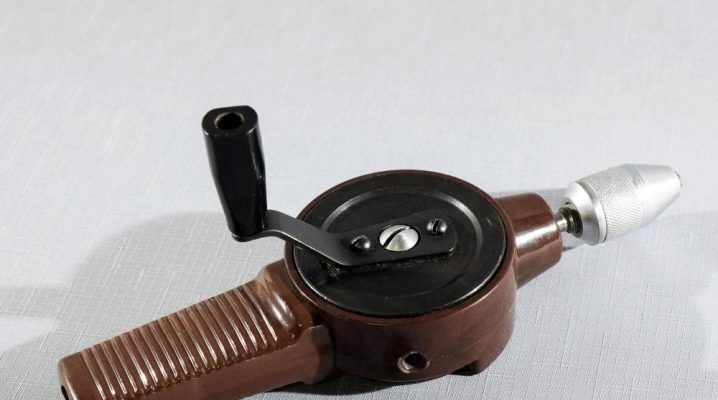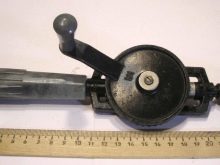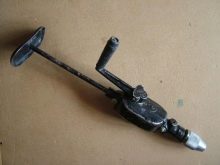Hand drills: choice, application, pros and cons

Despite the steadily growing popularity of electrified tools, the use of hand drills continues to be very relevant. Their choice is relatively small, however, they all boast many obvious advantages with a minimum number of disadvantages. The validity of this thesis is confirmed by both domestic and foreign craftsmen who continue to use these tools for the successful solution of various everyday tasks.


What it is?
A hand drill, also called a mechanical drill, has been used by humans for two millennia. At first, it was extremely primitive, representing a bronze lance with a curved top and a pointed tip. In the future, its design became more perfect, which led to the emergence of a brace - a tool capable of boasting the presence of a chuck for securely fastening drills.
As for the popular models of hand drills currently in use, they include a gearbox with gears, the previously mentioned chuck, the handle, the fixing handle and the stop tab. Using these tools, you can drill holes in a wide variety of materials, from malleable wood to concrete and highly durable metals.
Special attention should be paid to the efficiency of modern hand drills in comparison with rotors: at the same rotational speed of the handle, they have three times more productivity.

In addition to drilling, the tool in question can be used to solve the following tasks:
- marking;
- increasing the diameter of existing holes;
- creation of sockets for countersunk heads of screws, bolts and rivets;
- finishing machining.
In addition, some craftsmen use a hand drill as a replacement for a screwdriver and a mixer - provided that a suitable device is fixed in its cartridge.

pros
There are enough benefits fully justifying the use of the described tools.
- Simplicity of design. Due to the absence of a large number of components, power drills are easy to repair and do not need particularly careful maintenance. This allows you to significantly reduce the amount of time and money required to ensure the performance of the tool used. The solution to this problem does not differ in complexity: it involves the timely application of lubricants and the replacement of parts that have exhausted their working life.
- Reliability and durability. Experience shows that it is very difficult to break a hand drill, even with regular and very intensive use. This is due to the high quality of materials used in the manufacture of such tools (especially those that were produced during the Soviet era). Many power drills made several decades ago still work successfully, repeatedly justifying their initial cost.

- Autonomy. The described tools do not need electrical power, and therefore they can be used anywhere. This advantage of hand drills is especially true for those who have to work away from the usual benefits of civilization.
- Affordable price. Today, a new hand drill can be purchased for 600-1000 rubles, while a used mechanical "assistant" will cost even less (about half). In addition to the technical condition, the cost of the tool is influenced by its dimensions, equipment, body material and the reputation of the manufacturer.
Most often, craftsmen prefer two-handed drills, using them to create small holes and grooves. Careful execution of such work involves precise control of the drilling depth and extremely careful rotation, for which the described tool is most suitable.

Minuses
One of the main drawbacks of hand drills is their massiveness, due to the specifics of the parts used. Provided that the latter are made of cast iron, the mass of the tool can reach 3 kg, creating certain difficulties for the performer during work and transportation. Another drawback of such drills is their large dimensions: as a rule, craftsmen do not consider it critical, however, some craftsmen refuse to use hand tools for this very reason.
Separately, it is worth mentioning the application of physical efforts provided for by working with power drills.
This circumstance leads to the fact that many performers give preference to the power tool. In addition, hand drills are significantly inferior to the latter in performance, and therefore are practically not used when performing large volumes of work.



Varieties
Depending on the features of their design, the described tools are one- and two-speed. The former are used relatively rarely, which is explained by their low efficiency, while the latter are used much more often, since they have a more perfect design and are able to solve a variety of tasks.

Single speed
The classic hand drill belonging to this variety assumes the presence of a pair of gears, the rotation of which sets the chuck in motion. Most often, such tools are open - not involving the use of a protective case.
The main advantage of this design is maximum ease of application of lubricants.
As for the location of the gears, the larger one is connected to the handle, and the smaller one is connected to the chuck. Another feature of such drills is the presence of a handle, thanks to which you can securely fix the tool during operation.


Two-speed
The considered type of hand drill assumes the presence of a multiplier - a mechanical device also called an accelerator.
It consists of gears located on different axes in one housing, due to which the rotation frequency changes.
In order to change the speed of such a drill, it is enough to install the handle on the other side. This action leads to an increase or decrease in the gear ratio, which naturally affects the performance of the tool used. There are also such models of drills in which a longitudinal displacement of the axis of rotation of the handle is provided for changing the speed, and not the permutation mentioned above.
Also, power drills differ depending on the type of chuck used. Its design can provide for the presence of three or four cams - clamping elements that ensure reliable fixation of the rotating tool.



How to work with a drill?
To successfully solve problems using the described tool it is enough to adhere to useful recommendations.
- If a performer needs standard hole placement, he should pay attention to drill placement. During operation, it should be at right angles to the surface, without deviations in any direction. As for inclined holes, then to obtain them, you must position the drill at the desired angle.
- When completing drilling, it is necessary to reduce not only the rotational speed, but also the pressure - in order to avoid damage to the cutting tool. In addition, the fulfillment of this condition negates the probability of loss of balance by the master.
- To use a hand drill as a screwdriver, it is enough to fix a bit with a suitable tip in its holder. The mixer is also attached there - in situations where the tool in question performs the function of a mixer.
At the end of the work, the hand drill remains thoroughly cleaned of dust, shavings or sawdust.

Safety precautions and selection rules
One of the key conditions that every owner of a hand drill should observe is the safe operation of this tool. The latter provides for taking into account simple rules.
- You can drill a part only after it is securely fixed. Ignoring this condition may result in damage to the workpiece or injury to the performer.
- Do not touch the drills and nozzles - both during the operation of the drill, and after a short period of time has elapsed since its completion. This is due to the fact that the processing of hard materials with a fast-rotating cutting tool involves strong friction, the natural consequence of which is heating.
- After the drill is securely fixed, the performer should remove the key from the chuck.
- To prevent the cutting tool from dulling, it must be periodically cooled, taking breaks from work or applying a special suspension. Thus, you can not only extend the service life of the drill, but also make the holes more accurate.


In addition, safety goggles must be worn to avoid eye damage from chips and other small drilling debris.
In order for the purchased hand drill not to disappoint its owner, it must meet the following conditions:
- high quality workmanship of all visible structural elements (in the presence of burrs, sharp edges and other defects, it is advisable to refuse to purchase the tool);
- comfortable shape of the handle (a protective coating is also welcomed);
- smooth rotation of the cartridge;
- lack of extraneous noise during operation.

Special attention should be paid to the material of the handle, which can be wood or plastic.
Most often, experts prefer the first to the second, explaining this by the better wear resistance of this material.
As for the hand drill version, the optimal solution is a two-speed tool that has a lot of functions. This is especially true for complex work - tasks that are almost impossible to solve without changing the speed.


How to do it yourself?
Finally, it remains to talk about making the simplest hand drill on your own. The described method involves the use of an old umbrella, dowel and drill as components of the tool being created, as well as the simplest equipment - a hammer and a hacksaw for metal. Practice shows that this problem can be solved in a few minutes, adhering to the algorithm below:
- take an umbrella and cut off a fragment of the required length from its rod (together with a handle);
- bend the workpiece in two places at an angle as close as possible to a straight line;
- select a dowel of a suitable diameter and drive it into the tube to the maximum possible depth, then securely fix the drill in it.





If the master needs a thinner cutting tool, he will need another dowel, which must be driven into the already installed one. At the end of this action, it remains to take a drill of a smaller diameter and fix it as described above.
Summing up, we can state that hand drills deservedly enjoy their popularity. It makes sense to use them for anyone who appreciates reliable and unpretentious tools that can ensure high quality of work performed.

You can see an overview of a hand drill and how it works in the following video.













The comment was sent successfully.